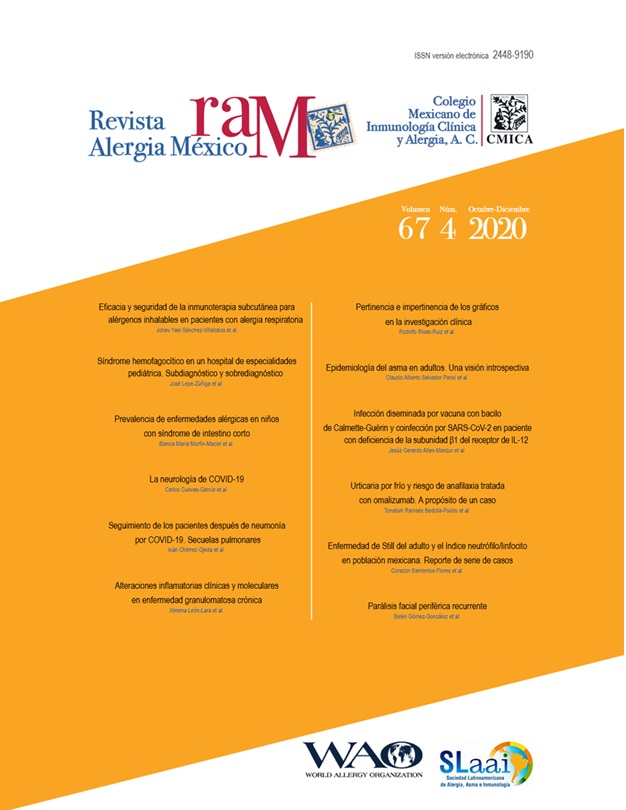Abstract
Background: Omalizumab, which is a monoclonal anti-IgE antibody, has recently been used as an option in the treatment of inducible urticaria.
Case report: We describe the case of a 46-year-old woman who was referred to the Department of Allergy and Immunology of “Hospital Civil de Guadalajara, Dr. Juan I. Menchaca” due to a history of hives, body itching, changes in the color of the skin after exposure to water, and chest tightness after the intake of cold beverages; therefore, she used to limit her outdoor activities and personal hygiene. We conducted challenge tests with heat, soaked towels, treadmill walks, and dermographism; which were negative. The ice cube test was positive. To establish the speed of wheal formation, we established intervals of exposure to cold of one, three, five, and ten minutes; a positive result was obtained from the third minute. Due to the poor response to the drug treatment and to measures to avoid the cold, as well as to the poor quality of life, the high risk of anaphylaxis, and the advent of winter season, omalizumab was administered at monthly doses of 150 mg during the winter season. After the first dose, there were no reports of episodes of hives in areas exposed to cold; the ice cube test was negative before the second dose and in the following months, and the patient was able to ingest cold beverages and cold food. There were no adverse reactions that could be attributable to the use of omalizumab. Three years after the first dose, the patient was still asymptomatic.
Conclusion: The described case is one of the first cases of cold urticaria with risk of anaphylaxis with a positive response to omalizumab, which was reflected in symptom control and the improvement in the quality of life.
References
Siebenhaar F, Weller K, Mlynek A, Magerl M, Altrichter S, Vieira-Dos Santos R, et al. Acquired cold urticaria: clinical picture and update on diagnosis and treatment. Clin Exp Dermatol. 2007;32(3):241-245. DOI: 10.1111/j.1365-2230.2007.02376.x.
Wanderer AA. Cold urticaria syndromes: historical background, diagnostic classification, clinical and laboratory characteristics, pathogenesis, and management. J Allergy Clin Immunol. 1990;85(6):965-981. DOI: 10.1016/0091-6749(90)90037-5
Alangari AA, Twarog FJ, Shih MC, Schneider LC. Clinical features and anaphylaxis in children with cold urticaria. Pediatrics. 2004;113(4):313-317. DOI: 10.1542/peds.113.4.e313
Zuberbier T, Aberer W, Asero R, Abdul Latiff AH, Baker D, Ballmer-Weber B, et al. The EAACI/GA²LEN/EDF/WAO guideline for the definition, classification, diagnosis and management of urticaria. Allergy. 2018;73(7):1393-1414. DOI: 10.1111/all.1339
Aguilar-Hinojosa NK, Segura-Méndez NH, Lugo-Reyes SO. Correlación de la gravedad de urticaria crónica y la calidad de vida. Rev Alerg Mex. 2012;59(4):180-186.
Jain SV, Mullins RJ. Cold urticaria: a 20-year follow-up study. J Eur Acad Dermatol Venereol. 2016;30(12):2066-2071. DOI: 10.1111/jdv.13841
Boyce JA. Successful treatment of cold-induced urticaria/anaphylaxis with anti-IgE. J Allergy Clin Immunol. 2006;117(6):1415-1418. DOI: 10.1016/j.jaci.2006.04.003.
Metz M, Schütz A, Weller K, Gorczyza M, Zimmer S, Staubach P, et al. Omalizumab is effective in cold urticaria-results of a randomized placebo-controlled trial. J Allergy Clin Immunol. 2017;140(3):864-867. DOI: 10.1016/j.jaci.2017.01.043
Guyatt GH, Haynes RB, Jaeschke RZ, Cook DJ, Green L, Naylor CD, et al. User’s guides to the medical literature: XXV. Evidence-based medicine: principles for applying the user’s guides to patient care. Evidence-Based Medicine Working Group. JAMA. 2000;284(10):1290-1296. DOI: 10.1001/jama.284.10.1290

This work is licensed under a Creative Commons Attribution-NonCommercial 4.0 International License.
Copyright (c) 2021 Revista Alergia México

